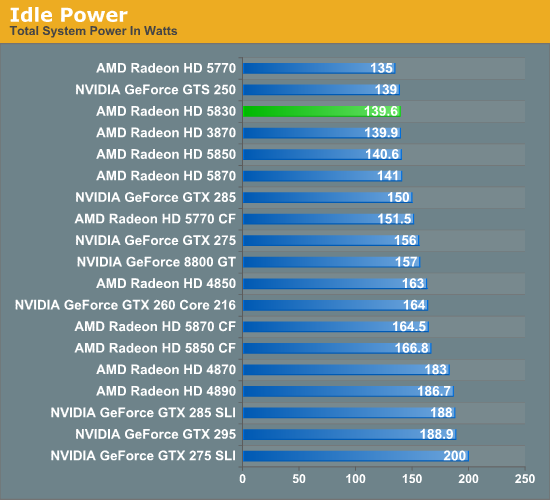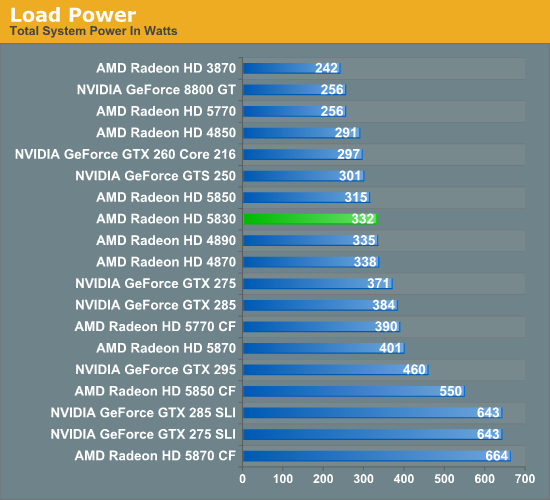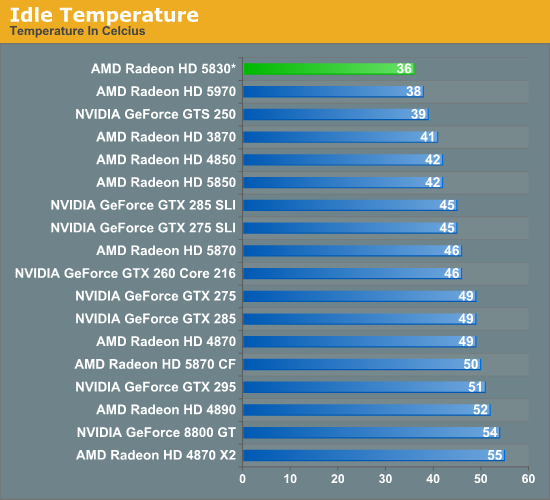AMD’s Radeon HD 5830: A Filler Card at the Wrong Price
by Ryan Smith on February 24, 2010 12:00 AM EST- Posted in
- GPUs
Power & Temperature
Since AMD isn’t doing a reference Radeon HD 5830, non-performance data is of limited value. Even with the variety of cards among AMD’s partners, the power draw of the 5830 cards should be within a few watts of each other and vary only with the difference in their fans so long as they use a 5870 PCB. On the other hand temperature data is going to heavily depend on the cooler used, and noise data is completely useless here since it entirely depends on the cooler used.
So we have power and temperature data for you, but please keep in mind that this temperature data is really only useful as a frame of reference – retail cards could be quite dissimilar.


At idle, the power usage is just as AMD promised: it’s a hair under the 5850, by a single watt to be exact. As far as high-end cards go, this is the least power hungry among them when idling.
Under load the story is quite a bit more interesting. We know the 5830 is rated for a TDP between the 5850 and 5870 that’s much closer to the 5870, but the power draw doesn’t reflect that. Here it’s 17W over the 5850, and nearly 70W off the 5870. We’ve double checked and the card isn’t throttling (a very possible situation given the higher voltage used) so we’re not quite sure what to make of these results. The 5830 is apparently more alike the 5850 than the 5870 when it comes to power consumption, which is certainly a good thing since it means it edges out the 4870 and 4890, and is well ahead of the GTX 275.


With an eye on the fact that this temperature data is going to be heavily dependent on the cooler used, for our sample card we certainly have some interesting results. Under idle this is the coolest of our high-end cards, which is no surprise given the use of the 5870’s big cooler and the lower idle power usage of the 5830. On the other hand under load, even with the otherwise minor difference in power draw compared to the 5850 and the bigger cooler it’s 5C hotter, which is actually more in-line with what we would have expected. However it still stays below the 4800 series and the 5870, both of which get warm enough that they really have to rev up their fans.
It’ll be interesting to see just how good the vendor coolers end up being. With the relatively low load power usage, the 5830 doesn’t have to be a particularly loud card.










148 Comments
View All Comments
MadMan007 - Thursday, February 25, 2010 - link
Since when is ATi taking marketing technique pointers from nVidia?"...the 5830 has some very useful advantages over the 4890 – DX/DirectCompute 11, Eyefinity, better OpenCL support, and bitstreaming audio..."
Substitute PhysX, CUDA, and 3D display and that would be an NV marketing line.
(btw why does using quote tags always throw an error in article comments?)
Ramon Zarat - Saturday, February 27, 2010 - link
I beg to differ. There are very clear distinctions between the technologies you mentioned!!!CUDA: Proprietary API, closed platform strictly regulated by Nvidia that will be soon obsolete due to OpenCL broad adoption. Market penetration is still limited to vertical market niches.
Stream: Based on OpenCl, an open platform supported by the whole community representing the future of the industry which will presumably enable any if not all applications and games properly coded and compiled to benefit from it.
PhysX: Proprietary API supported by only a dozen games out of which 10 are very bad.
Havok: Will transparently use OpenCL open standard to do in-game Physics, which will ensure a wide adoption.
Nvidia: Bitsreaming *REGULAR* audio over HDMI
ATI: Bitstreaming *TrueHD/DTS-HD Master Audio* audio over HDMI
3D vision: Proprietary API. Need one of *ONLY* 4 Nvidia approved 120Hz LCD, ( http://www.nvidia.com/object/3D_Vision_Requirement...">http://www.nvidia.com/object/3D_Vision_Requirement... ) and the games must be supported in driver. Costly setup, low market penetration.
Eyefinity: Actually work out of the box for 2D environment. You only need any 2 LCD/CRT + 1 LCD with display port (any brand) or a DVI/HDMI panel with an active converter. A 6 ports version is launching in a couple of weeks. For 3 panels gaming, game profiles are now outside drivers and available almost as soon as a new games come out. Drivers for games still need some polishing.
I try very hard to be objective, but the facts speak by themselves. ATI is doing better technology right now and shouldn't be ashame to publicize its superiority. By contrast, Nvidia's totalitarian TWIMTBP program, dictatorial proprietary stuff everywhere, and deceptive general attitude as of late ("late", as in the last 5 years...), are ethically highly questionable. The day ATI do the same, I will denounce them as well.
piroroadkill - Thursday, February 25, 2010 - link
Exactly, nobody gives a shit.The 4890 is faster and cheaper, the end
ImSpartacus - Thursday, February 25, 2010 - link
No kidding. I am so thankful that I got my 4890 when it came out. I only paid $225 for it too.It still hasn't been topped in its price point.
Makaveli - Thursday, February 25, 2010 - link
I picked up my 4890 in Oct for $189 and still laughing about it.I won't bother upgrading until the successor too the 5xxx series comes out.
kmmatney - Thursday, February 25, 2010 - link
I jumped on the MSI HD4890OC deal for $180 a year ago, and actually received the rebate after 4 months. Amazing that you can't spend the same amount of maney and get something that performs better a year later.strikeback03 - Thursday, February 25, 2010 - link
Not really that amazing, it is what happens when there is no real competition. If Nvidia can shock the world and drop something new and good at the $200 price point it is a good bet you will see the whole market adjust quickly.Deville - Thursday, February 25, 2010 - link
Exactly. It's silly to offer another card that performs in the range of last gen's cards. What's the point of "upgrading" if there's no upgrade?If it can barely keep up with last year's models, how can we expect it to do the DX11 stuff? And isn't the DX11 stuff pretty much the only reason to upgrade anyway?
Here's the problem when comparing new versions of 5000 series cards:
The numbering system helps, but we have precious little data to show us how DX11 even performs under these new cards.
I love reading your shootouts, but give us DX11 benchies, please.
san1s - Thursday, February 25, 2010 - link
that's exactly what I was thinkinggumdrops - Thursday, February 25, 2010 - link
Where are all the DX11 game tests like DIRT 2 or Alien vs Predator? BattleForge is the only one and it's unclear if the game was even run in DX11 mode for cards that support it.